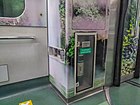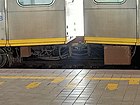LRTA 1200 class – Wikipedia
3rd-generation rolling stock operating at LRT-1
The LRTA 1200 class is the third-generation class of high-floor light rail vehicles (LRV) of the Light Rail Transit Authority (LRTA) in Manila, Philippines, which began operation in December 2006.[10]
Purchase[edit]
Package A of the LRT Line 1 Capacity Expansion Project Phase 2 included the procurement of 48 light rail vehicles (LRV), configurable to 12 four-car sets. In 2005, the joint venture of Sumitomo Corporation and Itochu received the order of 48 LRVs and signed a construction contract with Kinki Sharyo and Nippon Sharyo to manufacture and supply the vehicles.[11] The capacity expansion project was funded by Japan’s official development assistance.[12]
The LRV design is a 6-axle rigid body consisting of two articulated cars.
Car body[edit]
The car body has a length of 26 meters (85 feet 4 inches) without couplers, a width of 2.59 meters (8 feet 6 inches), and a height of 3.91 meters (12 feet 10 inches). 1200 class LRVs have 4 electronic sliding doors on both sides. The train car body is made of beadless lightweight stainless steel, with composite materials on the indoor panels and aluminum on the inner bone to reduce weight. 1200 class LRVs have 4 electronic sliding doors on both sides.
Each light rail vehicle has two roof-mounted air-conditioning units that has a cooling capacity of 41,000 kilocalories (170,000 kilojoules). In total, there are eight air-conditioning units in a four-car train set.
During the production of the 1200 class trains, a mock-up model was constructed. In December 2005, officials from the Light Rail Transit Authority and LRT-1 Capacity Expansion Project Phase 2 consultant Manila Tren Consortium inspected the mock-up model at the Kinki Sharyo factory in Osaka, Japan.[1] It was then displayed at the LRT Line 1 Baclaran Depot in Pasay City in March 2006. The length of the mock-up model is 14 meters (45 ft 11 in) long, or just 54% of the 26-meter (85 ft 4 in) vehicle length.[14]
-

A 1200 class train (front cab) at 5th Avenue station in October 2016.
-

A 1200 class train at Balintawak station in December 2021.
Interior[edit]
The interior is color-toned based on light and dark two-color green in the seats to complement the landscape of Manila. Seats are made of fiber reinforced plastic and has an aluminum bracket type cantilever longitudinal seat for reducing weight. Seating and grip sticks are designed to have ergonomic dimensions, aside from equipment arrangement inside the cab. A wheelchair-compatible space is provided beside the gangway of the intermediate car, alongside an equipped fire extinguisher.[1]
-

1200 class interior with new door stickers
-

Wheelchair strap and space, and fire extinguisher
Mechanical[edit]
The bogies are of inside-frame type, similar to the 1000 class. Like all LRT Line 1 rolling stock, the wheel diameter is 660 millimeters (25.98 inches). Each LRV has three bogies consisting of two motorized bogies at the ends of the LRV and one trailer bogie under the articulation. The primary suspension is a chevron rubber spring, while the secondary suspension is an air suspension, similar to the 1100 class.
Semi-permanent couplers are present in the ends of each light rail vehicle except the driving cab section of the MC car.
-

The inside-frame bogie of a 1200 class LRV.
-

Semi-permanent couplers of the 1200 class
Electrical[edit]
The traction control system is IGBT–VVVF that drives the four main motors of the two carriages. The traction motors are totally enclosed, self ventilated 3-phase AC induction motors with a power output of 105 kilowatts (141 horsepower). The traction equipment is manufactured by Mitsubishi Electric.
The auxiliaries are 440 volt alternating current static inverters and 110 volt direct current batteries.
Brakes[edit]
Knorr-Bremse manufactured the brakes of the 1200 class. The resistors are mounted on the roof for backup regenerative brakes. The VVVF controller has an Electronic Command braking device that uses regenerative and electronically controlled pneumatic brakes.Disc brakes are present on the bogies.
Operations[edit]
The 3rd-generation trains were inaugurated by Japanese Prime Minister Shinzō Abe and President Gloria Macapagal Arroyo on December 9, 2006 as part of the transportation capacity enhancement of the Manila LRT Line 1.[10] The trains raised the line’s capacity from 27,000 passengers per hour per direction to 40,000 passengers per hour per direction.[14]
On February 25, 2010, a 1200 class train was used in a test run of the LRT Line 1 North Extension and the MRT Line 3 as part of the MRT-LRT Closing the Loop project that intends to integrate the LRT Line 1 and MRT Line 3 operations, but the integration of operations has not been pursued.[17]
Out of the 12 sets, only 11 sets remain operational, with three light rail vehicles inoperable after a collision as of 2013.
The 1200 class trains operate in a 4-car configuration. However, there are some occurrences of 1200 class trains operating in a 3-car formation.
Special themed trains[edit]
In September 2018, a 3G trainset was decorated with a special “Gabay Guro” decoration to celebrate the National Teachers’ Month in the Philippines. The decoration has a library-themed look with images of books. The special themed train was launched on September 6, 2018 and ended a year later.[19]
Incidents[edit]
- On June 24, 2010, two trains (1G and 3G) collided at Balintawak station. As a result, LRVs 1248 and 1247 sustained damage. There were plans to restore it,[21] but the involved cars remain idle as of 2022.
- On February 18, 2011, two trains (1G and 3G) collided near Roosevelt Station in Quezon City at the reversing tracks, around a kilometer away to the east. There were no passengers on board when the incident happened.[22] This caused the Roosevelt and Balintawak stations to remain closed for two months until the stations were reopened on April 11, 2011. An investigation was conducted and was shown that one of the drivers was texting when the incident occurred.[23] This however caused LRV 1236, the 3G unit involved in the incident, to be in idle state and has not yet been restored for service.
- On May 23, 2015, thousands of passengers were stranded after two trains (1G and 3G) collided near the Monumento station. A train driver was hurt after the impact caused his head to slam into the dashboard of the train.[24] The accident, later revealed to be caused by power fluctuation that affected the signalling system, forced passengers to alight from the station until services was restored around 1 pm at the same day.[25]
- ^ For Kinki Sharyo-manufactured trains[1]
- ^ For Nippon Sharyo-manufactured trains
- ^ Total 4-car capacity. A single car can accommodate 347 passengers each.
- ^ 4-car train length. The length of a three-car train is 79.35 meters (260 feet 4 inches), while the length of a two-car train is 52.7 meters (172 feet 11 inches).
References[edit]
- ^ a b c “Osaka Inspection Tour” (Press release). Light Rail Transit Authority. December 12, 2005. Archived from the original on December 29, 2005. Retrieved February 17, 2022.
- ^ Department of Transportation and Communications; Light Rail Transit Authority (June 4, 2012). MANILA LRT1 EXTENSION, OPERATIONS AND MAINTENANCE PROJECT (PDF). Public-Private Partnership Center (Report). Retrieved April 9, 2018.
- ^ “LRTA LRV”. Kinki Sharyo. Archived from the original on July 17, 2011. Retrieved April 9, 2018.
- ^ a b c “PGMA, Japan PM inaugurate 3G trains” (Press release). Light Rail Transit Authority. December 7, 2006. Archived from the original on July 8, 2008. Retrieved April 21, 2022.
- ^ “ITOCHU Corporation”. Japan Overseas Railway System Association. Archived from the original on August 7, 2020. Retrieved November 27, 2021.
In the Philippines, we undertook the Manila LRT Line 1 Capacity Expansion 2 as a JV contractor and we supplied rolling stock and railway systems.
- ^ Japan International Cooperation Agency (2012). Ex-Post Evaluation of Japanese ODA Loan Project – LRT Line 1 Capacity Expansion Project (II) (PDF) (Report). Retrieved December 11, 2021.
- ^ a b “3rd Generation LRV Mock Up on Display” (Press release). Light Rail Transit Authority. March 9, 2006. Archived from the original on April 24, 2006. Retrieved November 27, 2021.
- ^ RTVMalacanang (February 25, 2010). MRT-LRT Closing the Loop Ride. YouTube. Event occurs at 1:37. Retrieved June 8, 2021.
- ^ “LOOK: ‘Gabay Guro’ train offers chance to rediscover joys of reading, learning”. ABS-CBN News. September 6, 2018. Retrieved September 5, 2021.
- ^ Department of Transportation and Communications (September 14, 2012). “Invitation to Bid – Rehabilitation and Restoration of Light Rail Vehicles (LRVs) Project” (PDF). Retrieved January 16, 2022.
- ^ Castro, Doland (February 18, 2011). “2 LRT trains collide”. ABS-CBN News. ABS-CBN News and Current Affairs. Archived from the original on May 26, 2020. Retrieved May 26, 2021.
- ^ Tan, Kimberly Jane (April 11, 2011). “LRT Balintawak, Roosevelt stations resume operations”. GMA News. GMA News and Public Affairs. Retrieved December 28, 2021.
- ^ Gonzales, Yuji Vincent (May 23, 2015). “2 LRT trains collide due to technical glitch; at least 1 hurt”. Philippine Daily Inquirer. Archived from the original on February 4, 2016. Retrieved May 26, 2021.
- ^ Palma, Paola (May 23, 2015). “Minor collision disrupts LRT operation Saturday”. CNN Philippines. Archived from the original on January 1, 2016. Retrieved May 26, 2021.
Sources[edit]
- Kinki Sharyo (October 2006). New product マニラ1号線向け連接電車 (PDF) (Report) (in Japanese). Archived from the original (PDF) on April 9, 2018.
- Nippon Sharyo (January 2007). フィリピン・マニラ都市圏軽軌道公社殿向けLRT1号線用車両完成 (Report) (in Japanese). Archived from the original on November 16, 2015.
- Knorr-Bremse Group (PDF) (Report). September 22, 2011.
- Japan International Cooperation Agency; Oriental Consultants Co., Ltd.; ALMEC Corporation; Katahira & Engineers International; Tonichi Engineering Consultants, Inc. (July 2013). Study on railway strategy for enhancement of railway network system in Metro Manila of the Republic of the Philippines: Final report, Vol.1-LRT Line 1: Cavite extension project (2013) (PDF) (Report). Archived (PDF) from the original on December 27, 2021. Retrieved December 27, 2021.
- Japan International Cooperation Agency; Oriental Consultants Co., Ltd.; ALMEC Corporation; Katahira & Engineers International; Tonichi Engineering Consultants, Inc. (July 2013b). “Appendices” (PDF). Study on railway strategy for enhancement of railway network system in Metro Manila of the Republic of the Philippines: Final report, Vol.1 LRT Line 1: Cavite extension project (2013) (Report). Archived (PDF) from the original on December 27, 2021. Retrieved December 27, 2021.
- Department of Transportation and Communications; Light Rail Transit Authority (September 14, 2012). PROJECT NO. 5B Restoration of Two (2) 3rd Generation LRVs (RE-BID) (PDF) (Report). Archived (PDF) from the original on December 28, 2021. Retrieved December 28, 2021.
Recent Comments